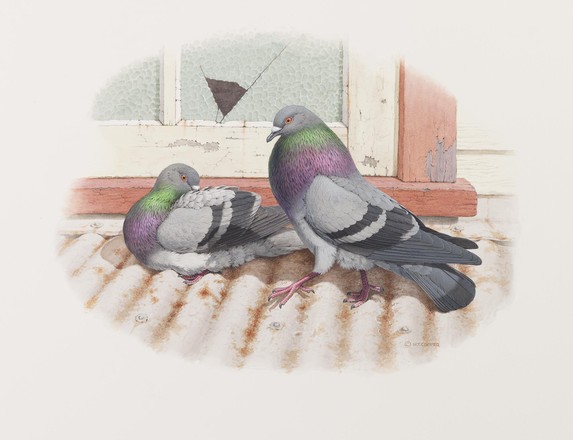(Feral pigeon) Columbia livia domestica
2009
Watercolour Plate,
Pigeons and Doves in Australia,
2005–2009
PXD 1408 / 1
New South Wales artist, Bill
Cooper’s scientific natural history illustrations, especially of birds, earned
him global renown. Self-taught and particularly respected for his species
knowledge and extreme precision, Cooper’s attention to detail enabled him to
captured the exact display of his avian subjects, each set within their natural
environment. This image is from Cooper’s final series of bird paintings, about
which he said, ‘I have always had an interest in pigeons and thought they would
make a nice book…’; this volume won the Royal Zoological Society of NSW’s
2015 Whitley Award for the most outstanding illustrated text on the fauna of
the Australasian region.
Bill Cooper
By Margot Riley
From the dense rainforests of north
Queensland to the cold, windswept heath lands of Tasmania, most regions of
Australia are frequented by one or more species of doves and pigeons of which William
Cooper claimed to have observed each in its exact habitat to ensure scientific accuracy. Pigeons and Doves in Australia is Joseph
Forshaw and William Cooper's final bird monograph and the illustrations are
some of Cooper's best. The 31 species of pigeons and doves found in Australia
are all illustrated with a full page plate, supplemented throughout the text by
smaller coloured drawings and study sketches.
William T (Bill) Cooper
(1934-2015) began his career as a self-taught landscape and seascape artist in
Newcastle, NSW. Copper first encountered the work of John Gould at a young age
but, though he expressed an early desire to paint like the great 19th
century avian artist, there was no market for bird illustration in Australia at
the time.
Instead, growing up in the
suburban shantytowns of Newcastle during the 1940s, as a teen Cooper learned to
be taxidermist at the now defunct Carey Bay zoo. Leaving school at 15, it was while working as a
window dresser and clothing store salesman in the late 1950s that he began
painting large private murals for hotels and private homes, and commercial
landscapes and seascapes from 1964 onwards. Cooper's breakthrough came at the
end of 1968 when he illustrated his first book, A Portfolio of Australian Birds. Then in April 1970, Cooper
achieved his dream of painting spectacular birds when made his first visit out
of Australia to see and paint Papua New Guinea's more unusual parrots.
Bill Cooper, the man whom legendary BBC TV naturalist Sir
Richard Attenborough viewed as one of the greatest of all bird artists, went on
to become world-famous, living with his wife and collaborator, Wendy, in
tropical north Queensland and painting until his death, at the age of 81, in
June 2015.



 Back to list
Back to list